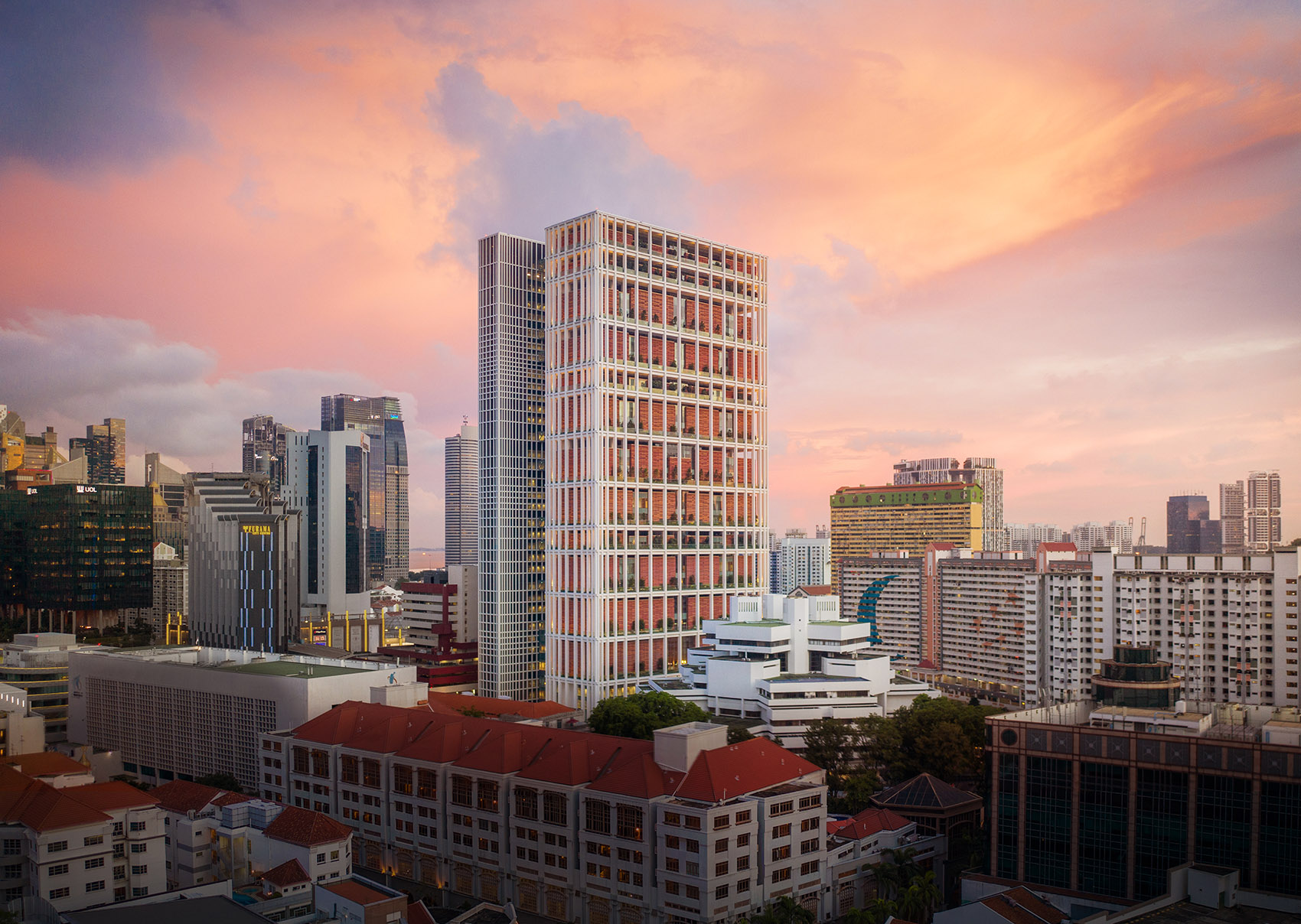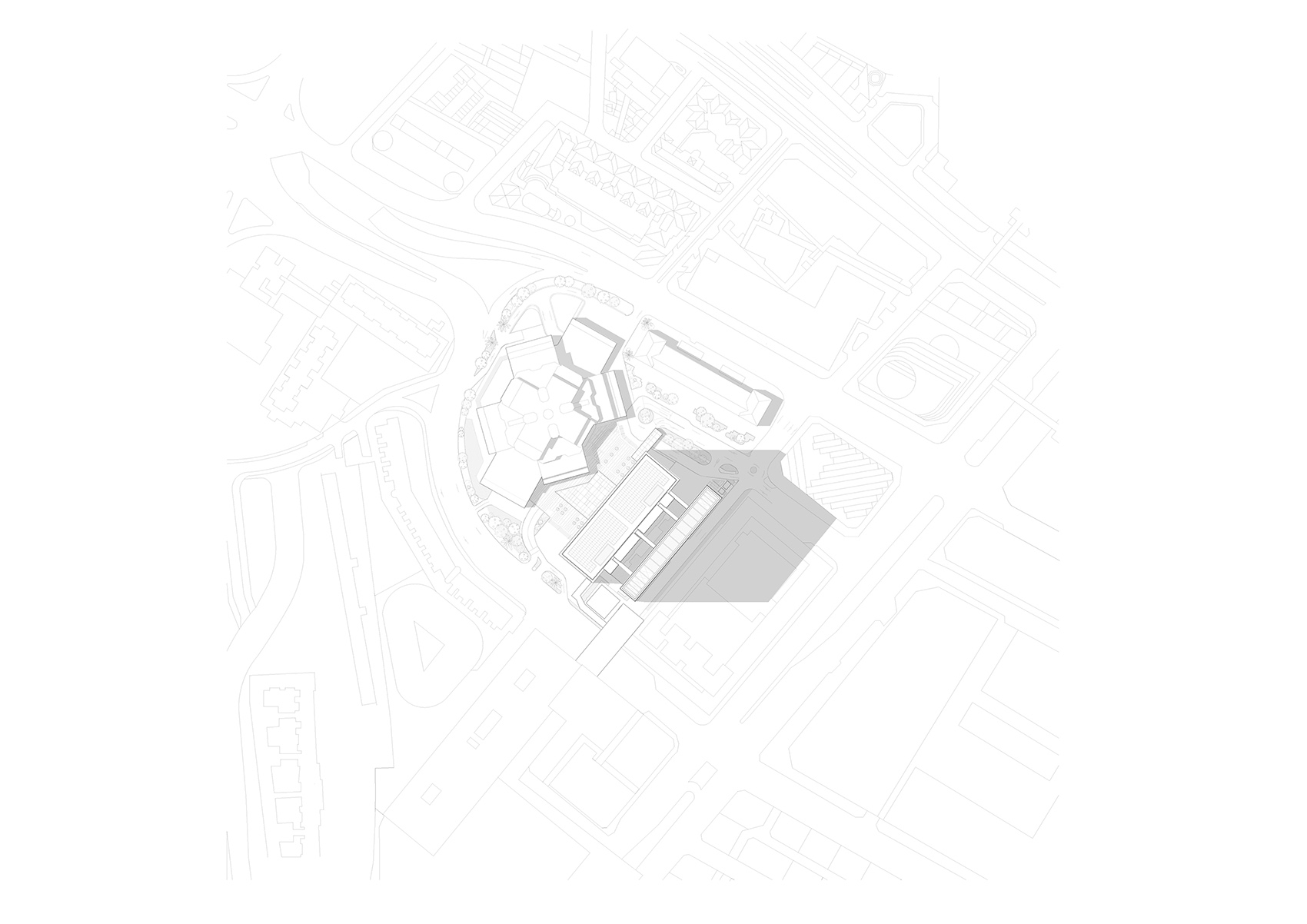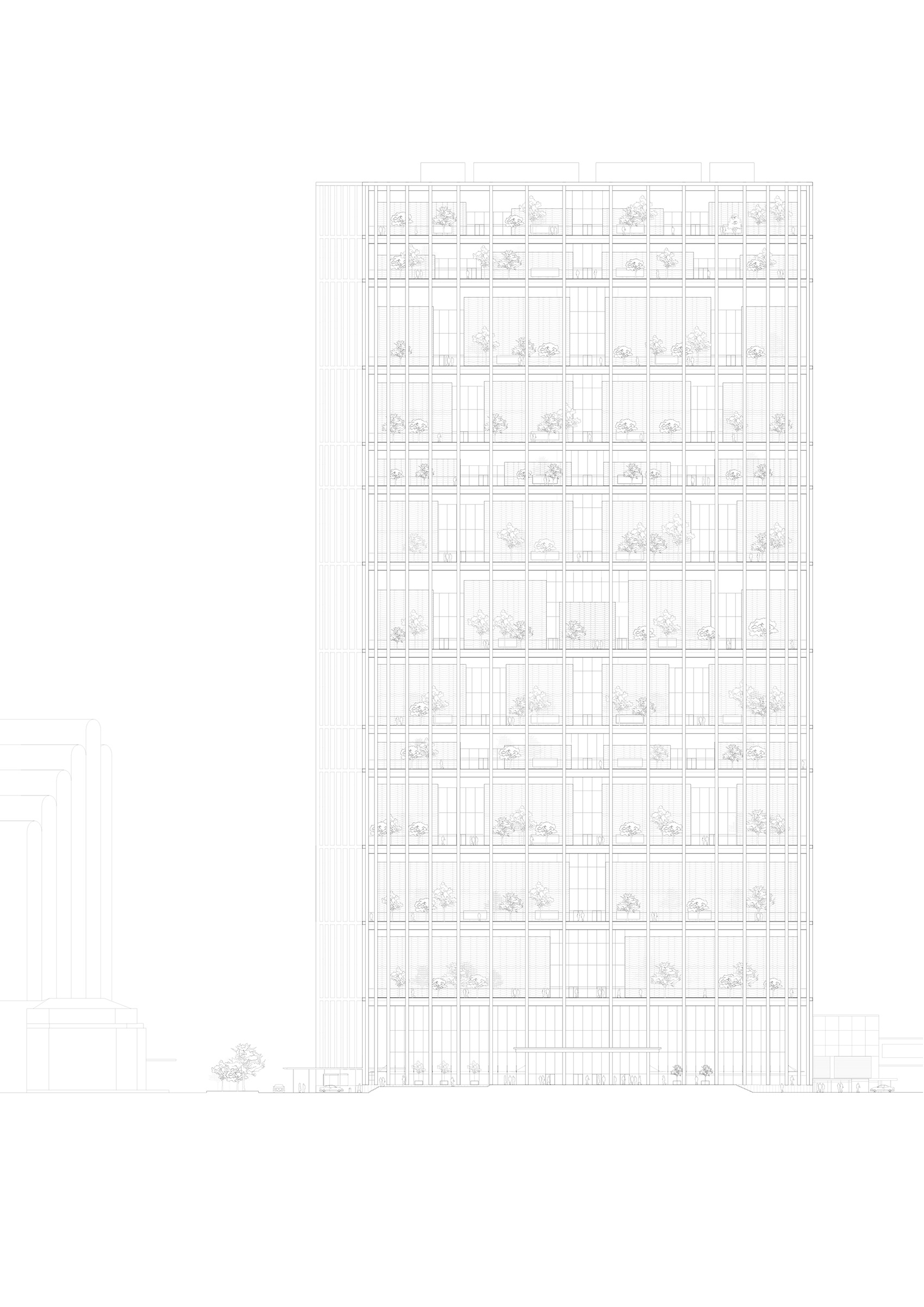在首席大法官Sundaresh Menon主持封顶仪式近两年后,位于新加坡Havelock广场1号的新国家法院大楼终于在2021年6月30日全面投入使用。新国家法院大楼是新加坡迄今为止最高的政府大楼,由Serie和Multiply事务所共同设计,其方案在2011年由国家法院举办的双阶段公开设计竞赛中获胜。本项目是与CPG公司(兼任首席顾问及建筑师)合作开发并完成。
Nearly two years after the topping-out ceremony officiated by The Honourable Chief Justice Sundaresh Menon, the new State Courts towers standing at 1 Havelock Square today is fully operational, and is the tallest government building in Singapore to date. The new State Courts towers was designed by Serie + Multiply Consultants Pte Ltd, winner of a public two-stage open design competition organised by the State Courts in 2011. The project was developed and completed in collaboration with CPG Consultants Pte Ltd which is the Principal Consultant and Architect.
▼建筑概览,Exterior view © Finbarr Fallon
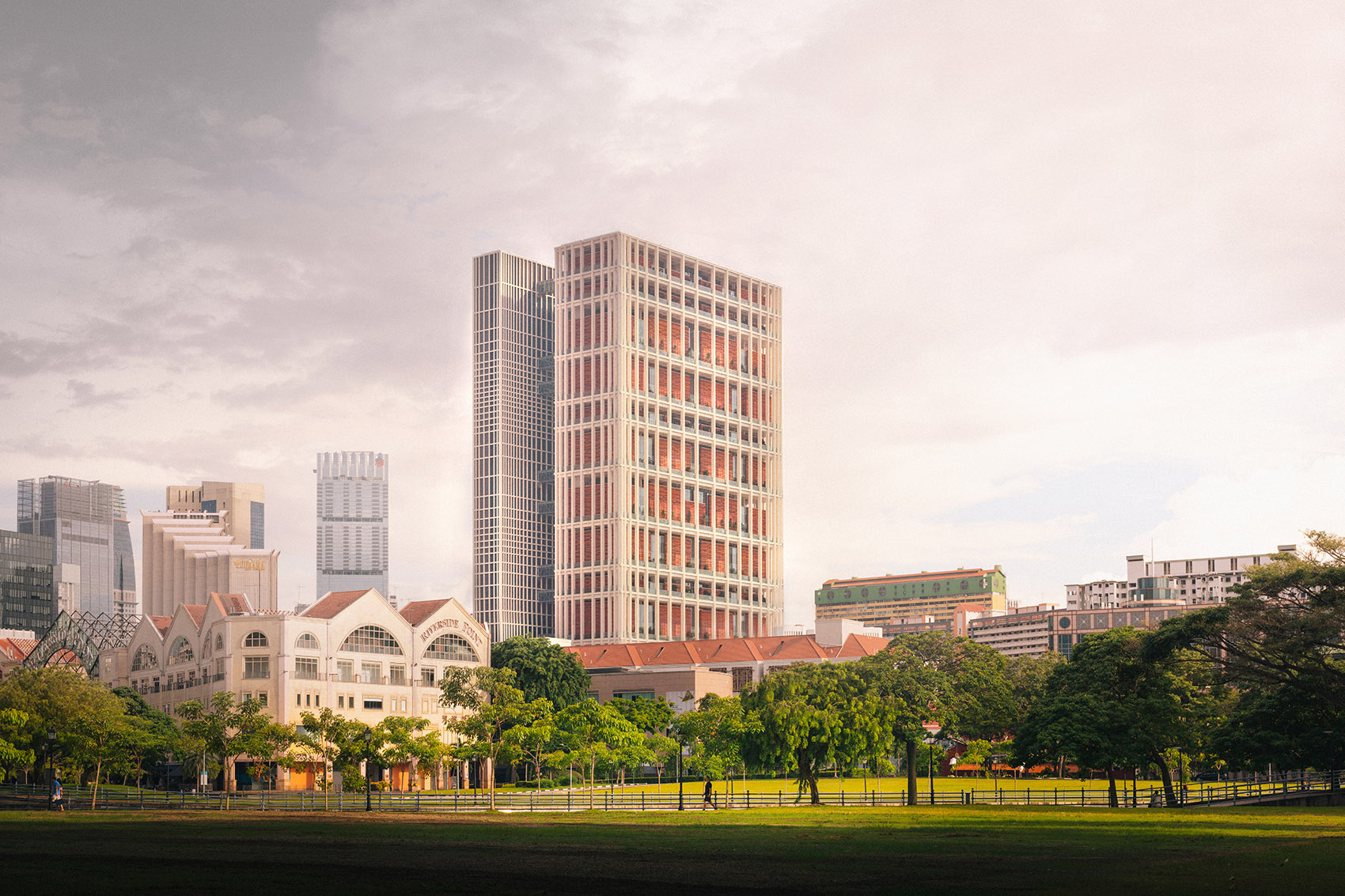
考虑到复杂的交通动线要求,法院综合体的设计通常遵循保守的方式,从而能够保证法官、在押人员与公众相互分离。
英国Serie Architects负责人Christopher Lee表示:“城市与市政建筑之间的关系是该项目所关注的重点。新国家法院大楼应当是一座向公众开放且具有象征意义的建筑。它的设计语言来自于其所在城市中的典型建筑,因而会给市民留下既熟悉又崭新的印象。”
Courtroom complexes are typically designed in a conservative manner partly due to complex circulation requirements to keep the judges, persons-in-custody, and the public separate.
Christopher Lee, Principal at Serie Architects, UK comments, “The relationship between the city and its civic buildings was our primary interest for this project. The new State Courts towers should be a building that is symbolically open and accessible to the public. Its design language is drawn from the architecture typical of the city and hence is both familiar and surprisingly new to its citizens.”
▼入口门廊,The entrance porch © Finbarr Fallon
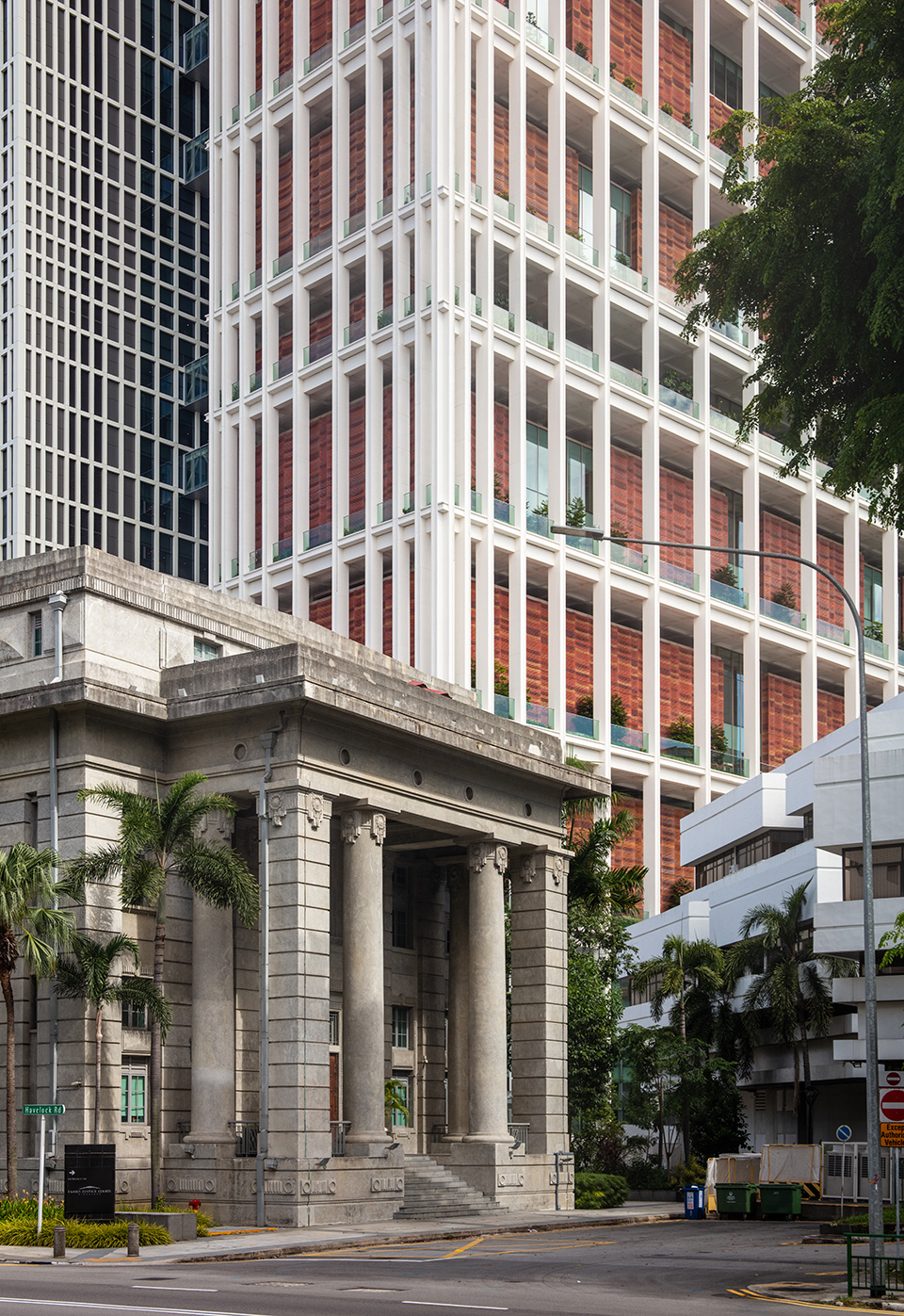
新国家法院大楼被赋予了不同于一般设计的开放性和可见度,主要通过两个建筑策略来实现。首先,建筑被分为两个细长的体量,并通过连桥贯通。法庭位于前方的塔楼,法官室和工作人员办公室位于后方的塔楼。该举措不仅保证了光线能够透入建筑深处,还有助于保证法官、在押人员与公众的顺利通行。
In contrast, the new State Courts towers have been designed to be highly open and visible to the public. This is achieved with two architectural strategies. First, the building is split into two slender towers connected by link bridges. The front tower accommodates courtrooms and the back tower the judges’ chambers and staff’s offices. This architectural move not only brings light deep into the building but helps keep the circulation of the judges, persons-in-custody, and the public separate.
▼建筑被分为两个细长的体量,并通过连桥贯通 © Finbarr Fallon The building is split into two slender towers connected by link bridges
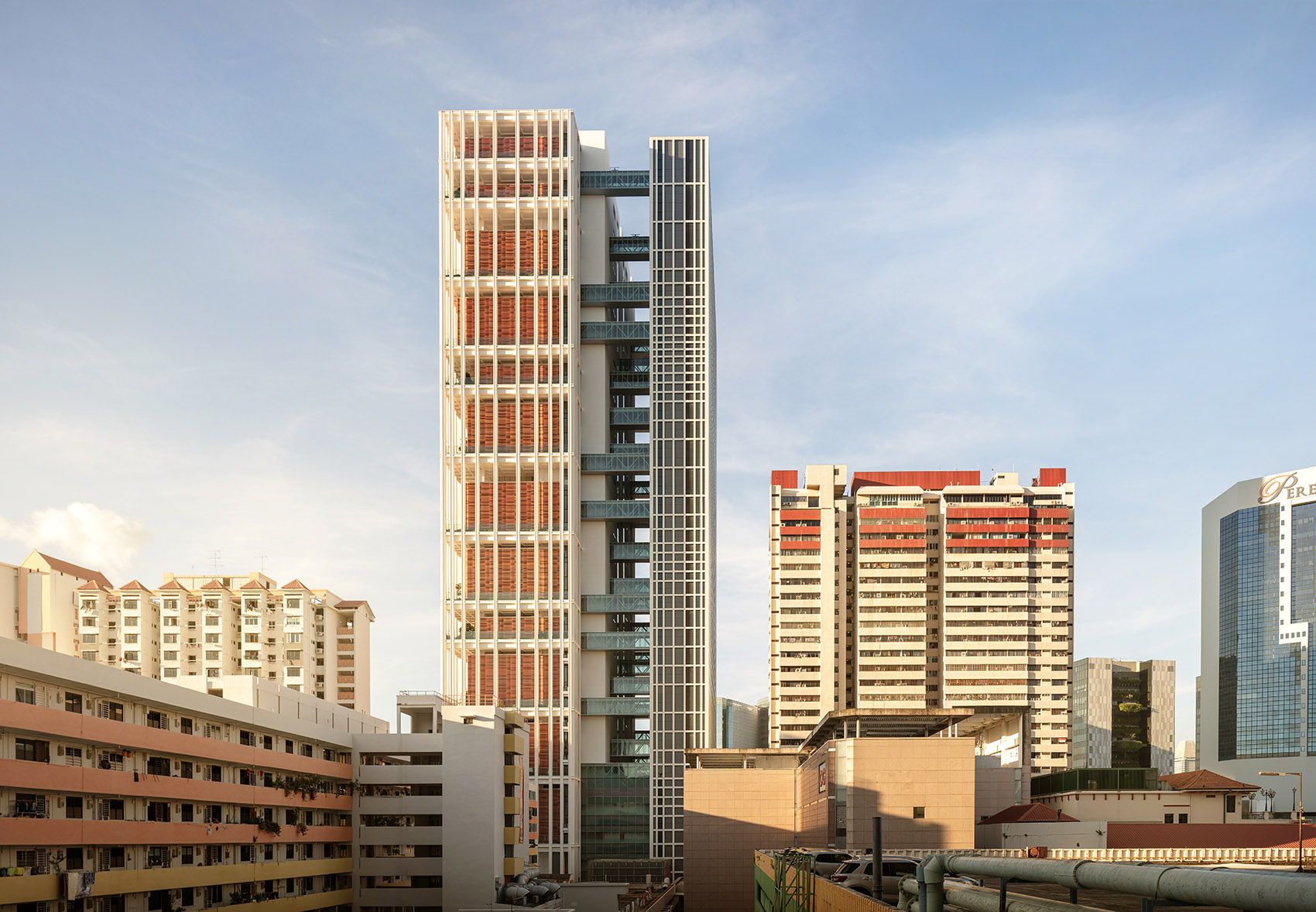
▼连桥外部近景,Exterior view towards the link bridges © Finbarr Fallon
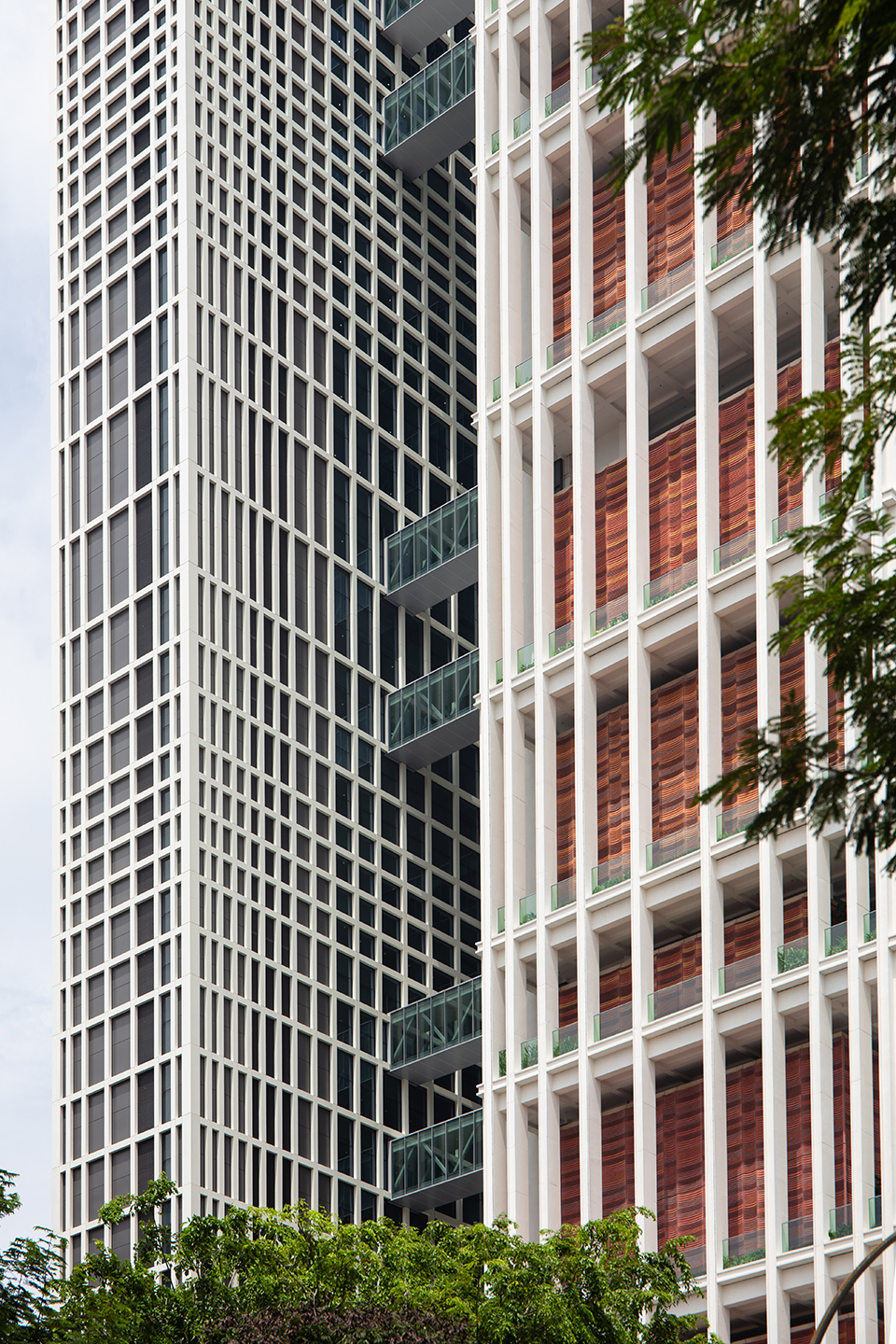
▼从两座体量之间望向连桥 © Khoo Guo Jie View towards the link bridges between the two volumes
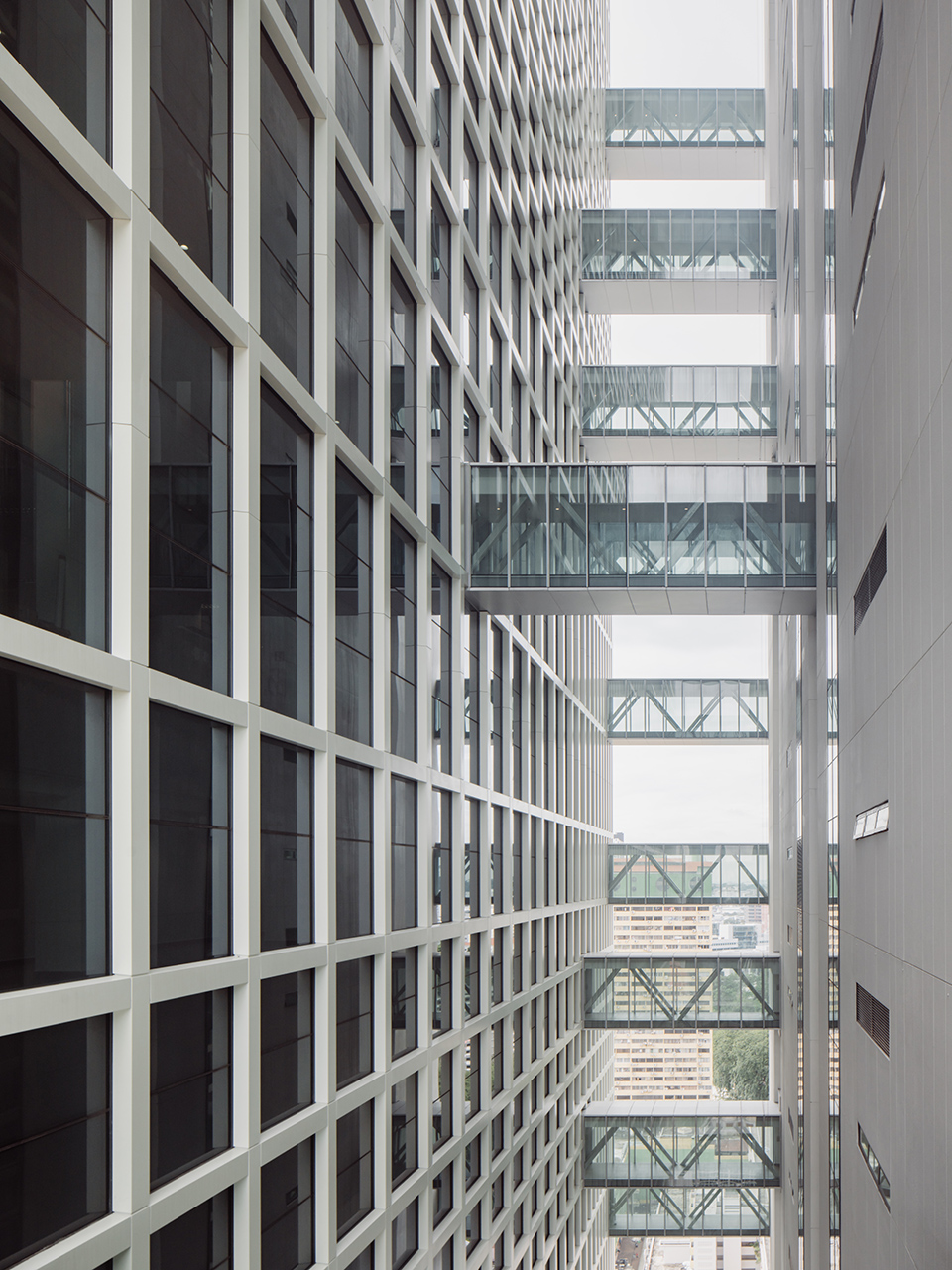
第二个策略是将法庭所在的一系列盒子空间设置在宽阔且开放的“托盘”上。这些托盘不仅可以通过变化的高度来适应法庭的不同尺度,还保持了完全开放的状态——塔楼四周没有设置任何玻璃外墙,且每个托盘上还设置了植物茂盛的花园露台,在过滤热带阳光的同时还提供了眺望城市的视野。法院大楼也因为这些空间的存在而显得更加轻盈、开放和友好。
The second strategy is to place the courtroom boxes onto large open “court trays”. These trays are not only of different heights to fit courtrooms of different sizes, but also completely open – there is no glazed facade around the tower. Instead, each tray accommodates a lushly planted garden terrace that filters the tropical sun and allows views out over the city. The court tower as a result appears light, open, and welcoming.
▼法院大楼的外墙,Facade of new State Courts towers © Finbarr Fallon

▼入口鸟瞰,Aerial view to the entrance © Khoo Guo Jie

法庭所在的体量采用了彩色的大型预制板饰面,每块板面的高度为5-12米,其灵感来源于附近唐人街店铺的瓦屋顶的颜色和纹理。选择此种材料的目的是将周围区域的两种典型建筑形式(即高层建筑和店屋)结合起来,从而为建筑赋予一种既令人熟悉又充满新意的观感。
The courtrooms themselves are clad in tall pigmented pre-cast panels measuring 5 to 12 metres in height, inspired by the colours and textures of the tiled roofs in the adjacent, historic Chinatown shophouses. The intention is to bring together two typical forms of architecture from the immediate area, namely the high-rise and the shophouses into a single frame so that the new building is at once familiar and yet excitingly new.
▼彩色预制板饰面呼应了附近唐人街店铺的瓦屋顶的颜色和纹理,Terracotta roofs of shop houses in Chinatown, adjacent to the new State Court towers © Finbarr Fallon
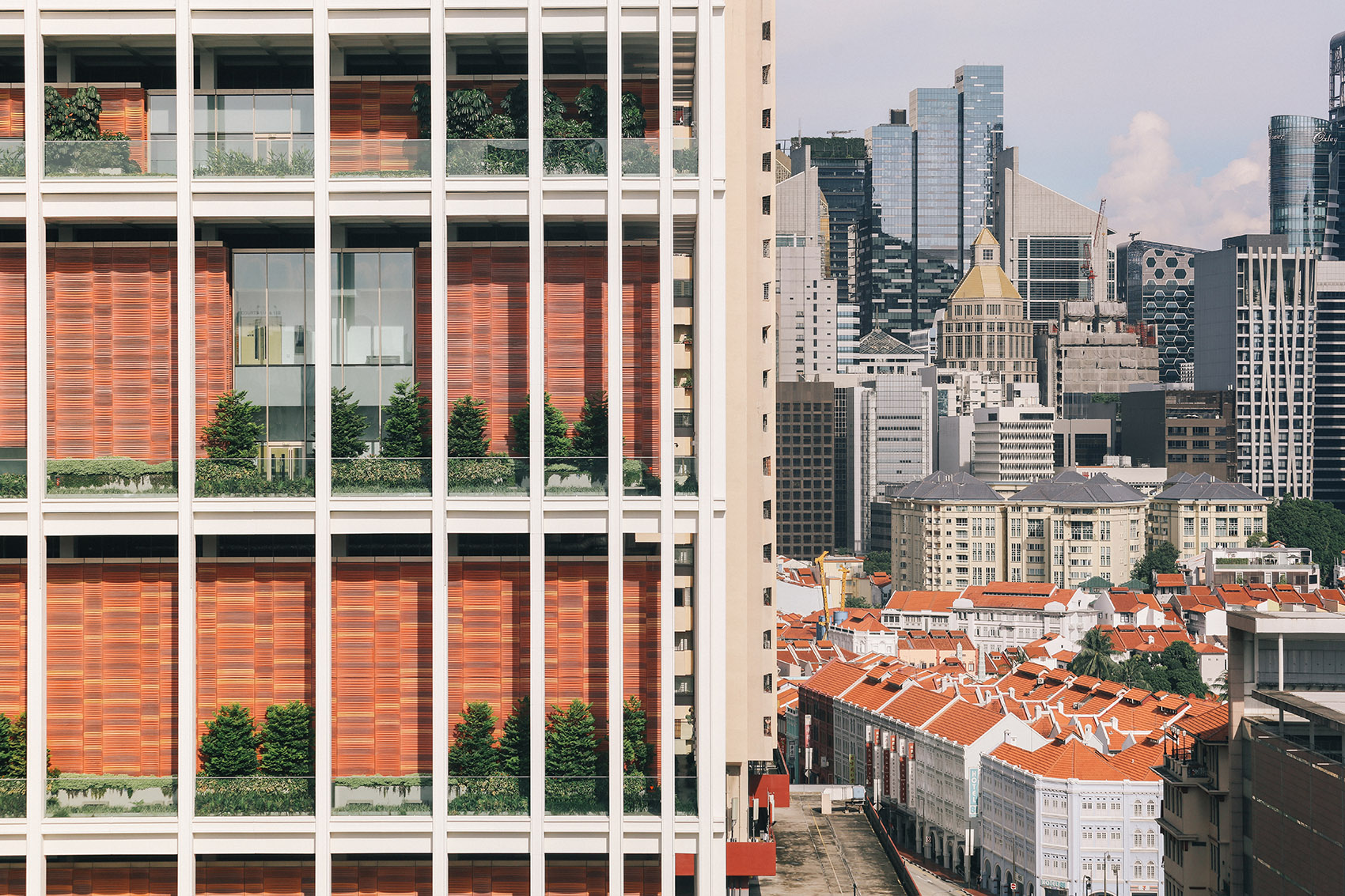
▼花园露台,garden terrace © Khoo Guo Jie
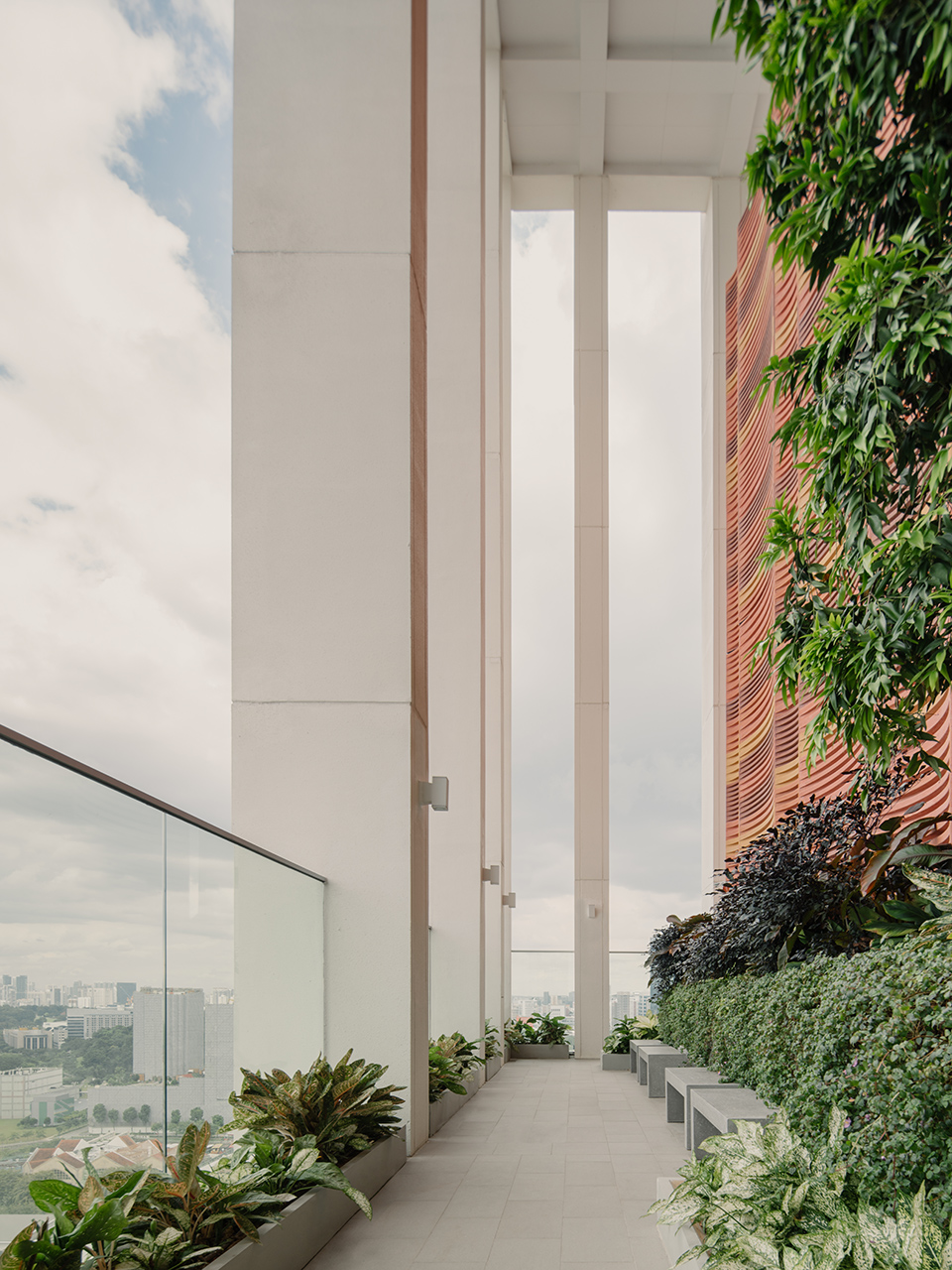
▼预制板墙面细部,wall details © Khoo Guo Jie
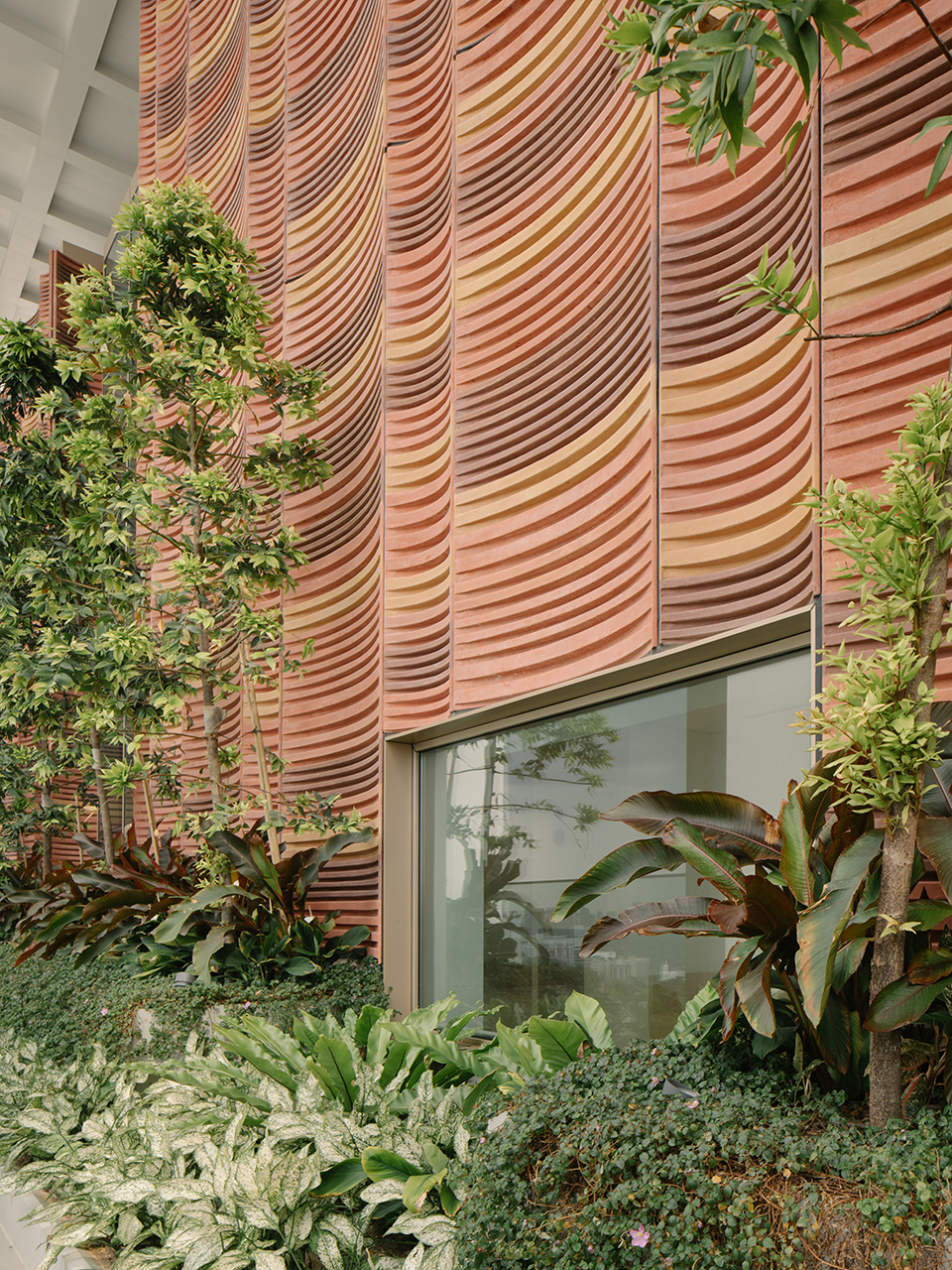
办公区所在的体量呈现为一个轻薄而又优雅的板状塔楼,其外立面被疏密有致的网格覆盖:垂直方向上,网格在服务核心筒的位置变得密集,在中央需要采光和视野的位置则变得分散;水平方向上,网格的有序变化将人们的视野引向墙外的天空,同时塑造出干净纯粹的形式和富有意趣的韵律感。
The office tower which houses working spaces is expressed as a thin and elegant slab tower. The facade features an expanding and contracting grid. Vertically, the grid contracts where the service core is located and expands where light and views are required in the middle. The modulation of the horizontal grids draws the eye across the facade and towards the sky, giving a clean and absolute form and a sense of playful rhythm.
▼办公楼的外立面被疏密有致的网格覆盖 © Finbarr Fallon The facade of the office tower features an expanding and contracting grid
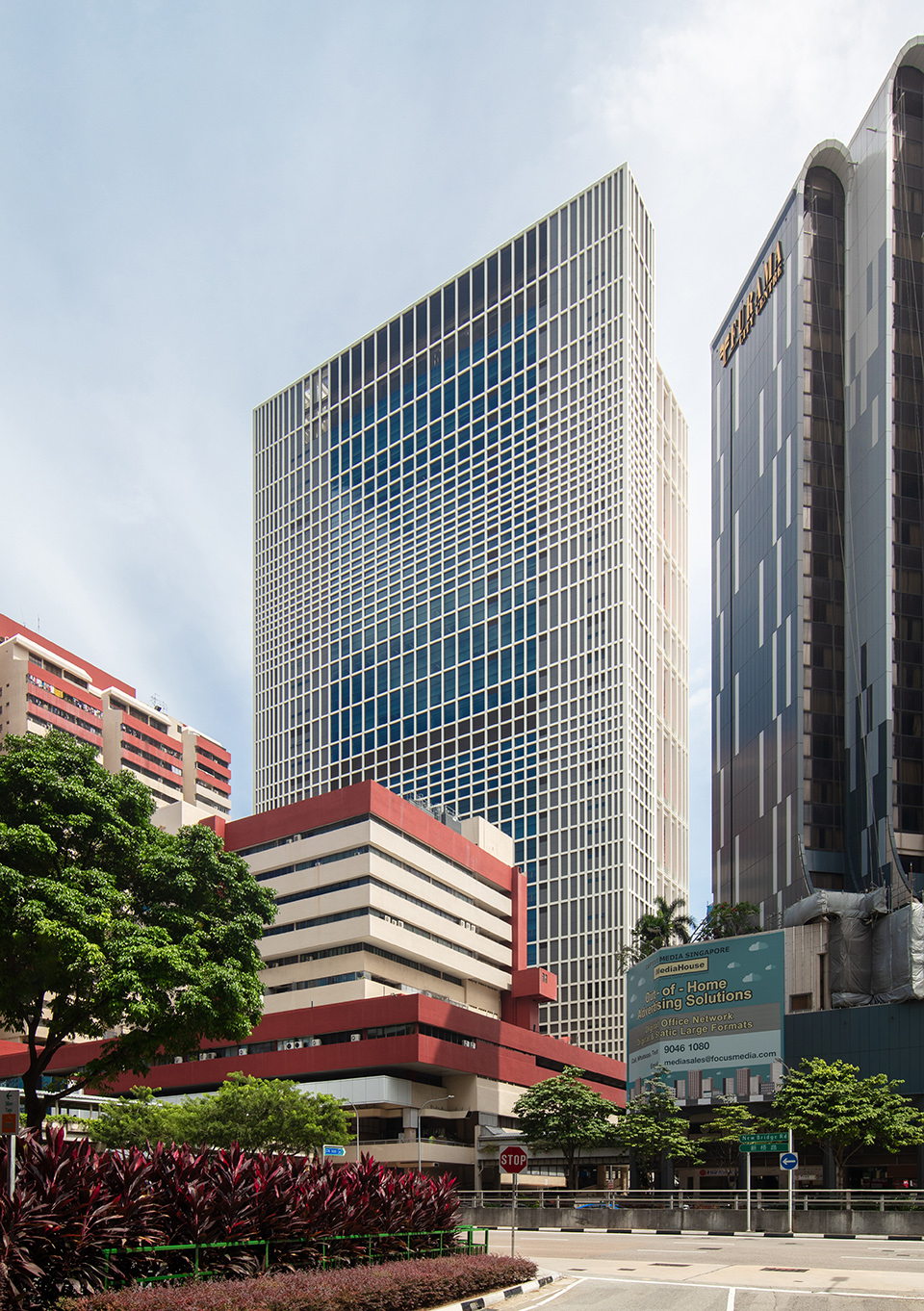
▼网格塑造出干净纯粹的形式和富有意趣的韵律感 © Khoo Guo Jie The modulation of the horizontal grids gives a clean and absolute form and a sense of playful rhythm
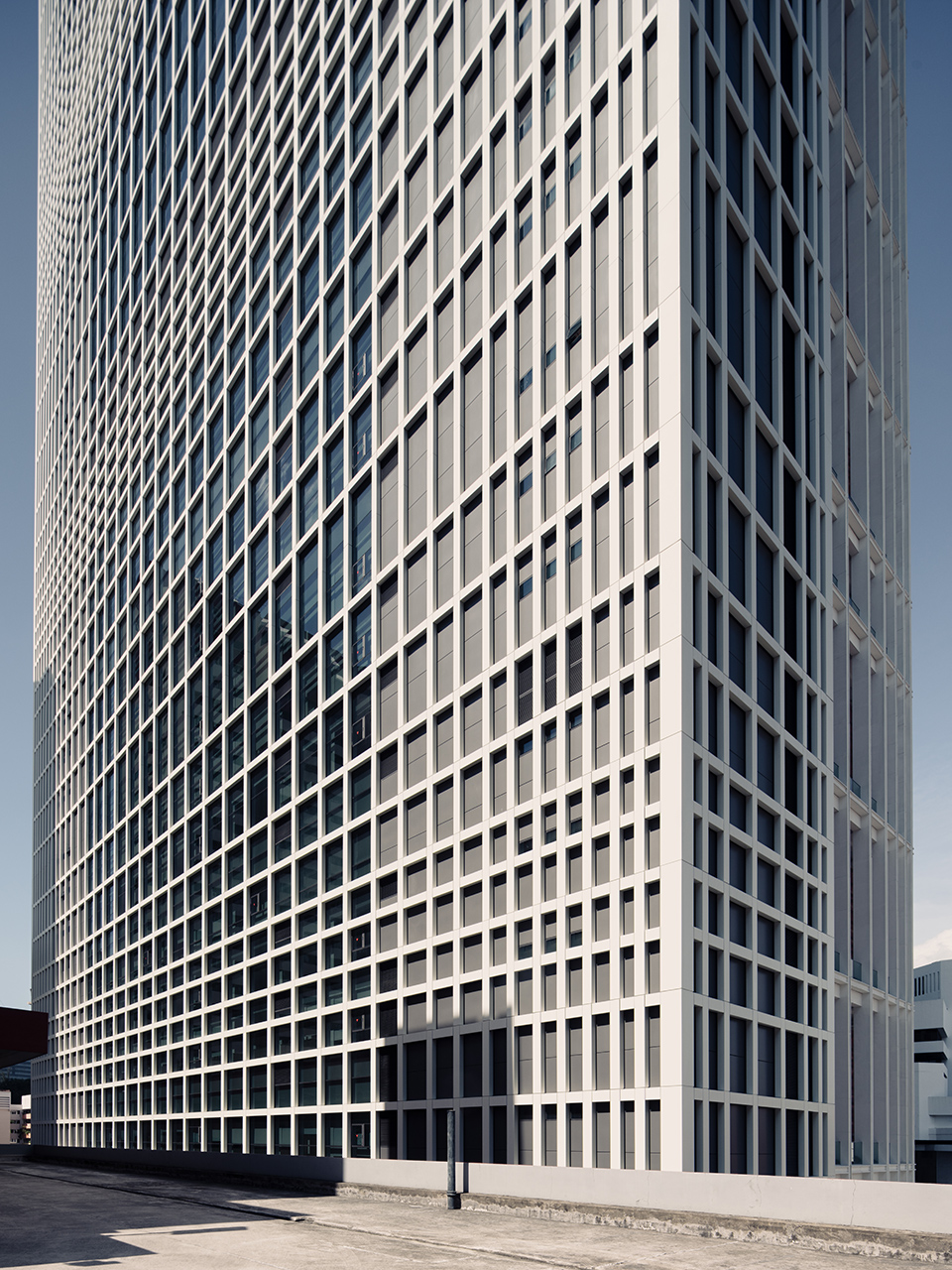
新建的入口雨蓬使法院大楼进一步向周围环境敞开,并分别在Havelock广场和上十字街创造出两个入口路径。
An entrance canopy was built for the new State Courts towers which opens up the site to the surrounding context and creates two entrances, the entrance from Havelock Square and Upper Cross Street.
▼立面细节,Facade detailed view © Khoo Guo Jie
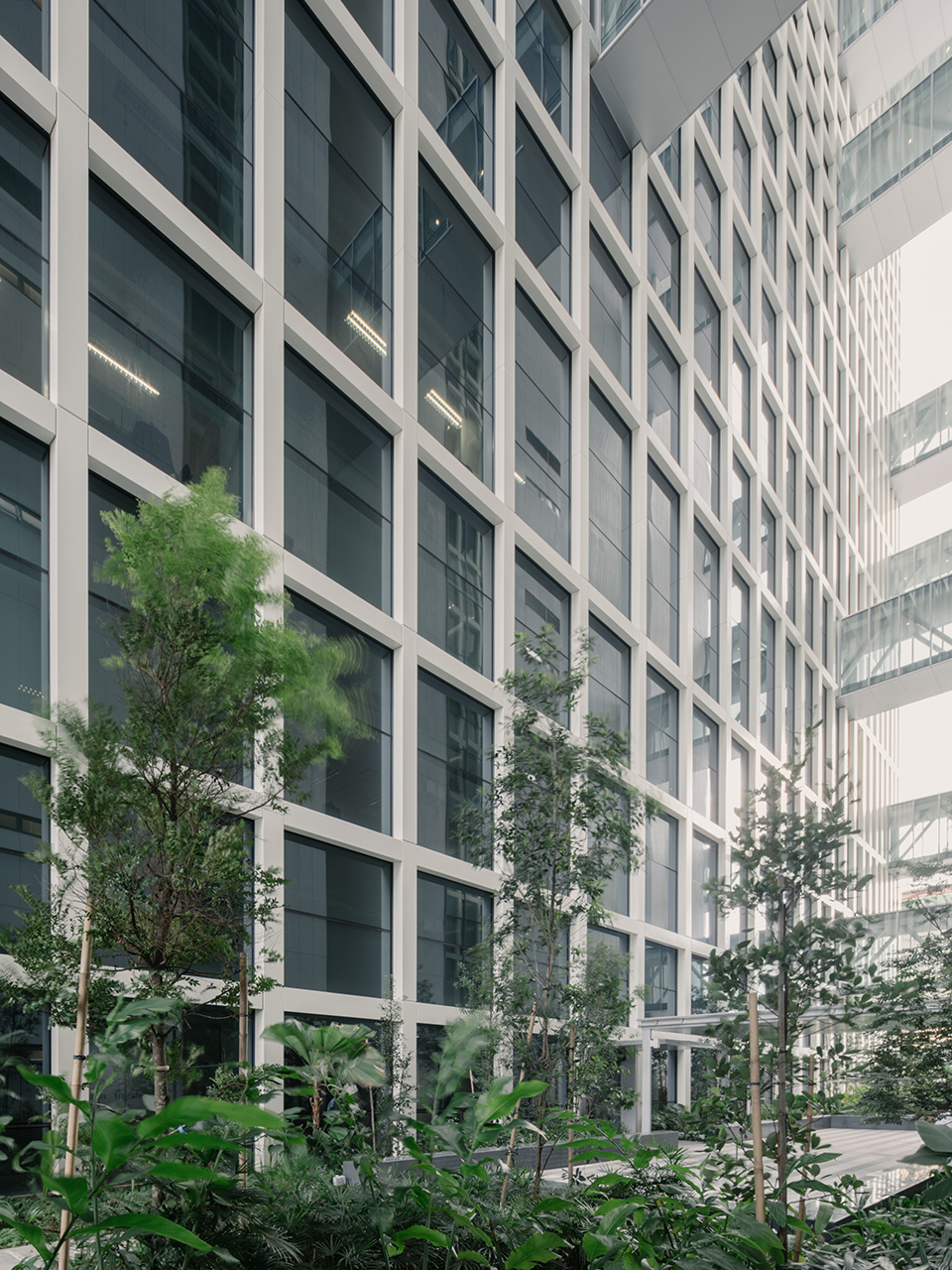
在谈及法院规划的复杂程度时,CPG公司首席建筑师及高级副总裁Colin Wu解释说:“CPG曾经为新加坡设计和建造过众多法院建筑,例如最高法院和家庭司法法院等。我们对新加坡法院建筑的设计和规划较为熟悉,这也有助于我们为新法院综合体打造出合适的功能空间,使其运行顺畅并符合安全要求。在这个项目中,我们的目标是确保三个主要用户群,即法官、在押人员和公众,在功能空间的规划上能够实现明确的分离。”
新国家法院大楼所在的场地面积较为有限,这意味着设计必须采用垂直形式而非更加常见的水平布局,同时还要对53个审判室和54个听证室进行谨慎的规划和排布,以确保法院在不受任何阻碍的条件下运作。最终,功能空间的垂直堆叠兼顾了高效性和简洁性,使公众可以非常容易地辨别大楼内的方向。
▼轴测示意图,Illustration © CPG Consultants
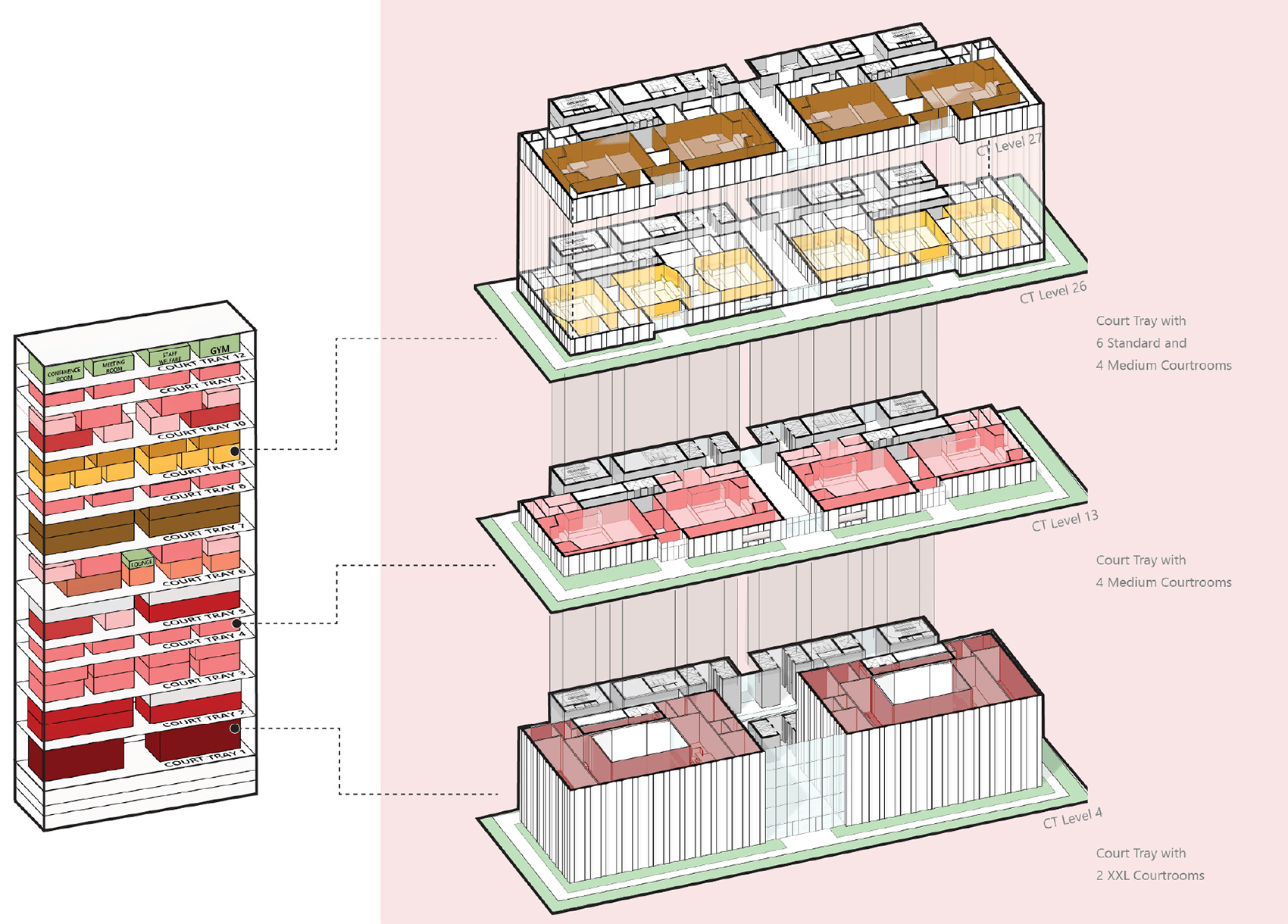
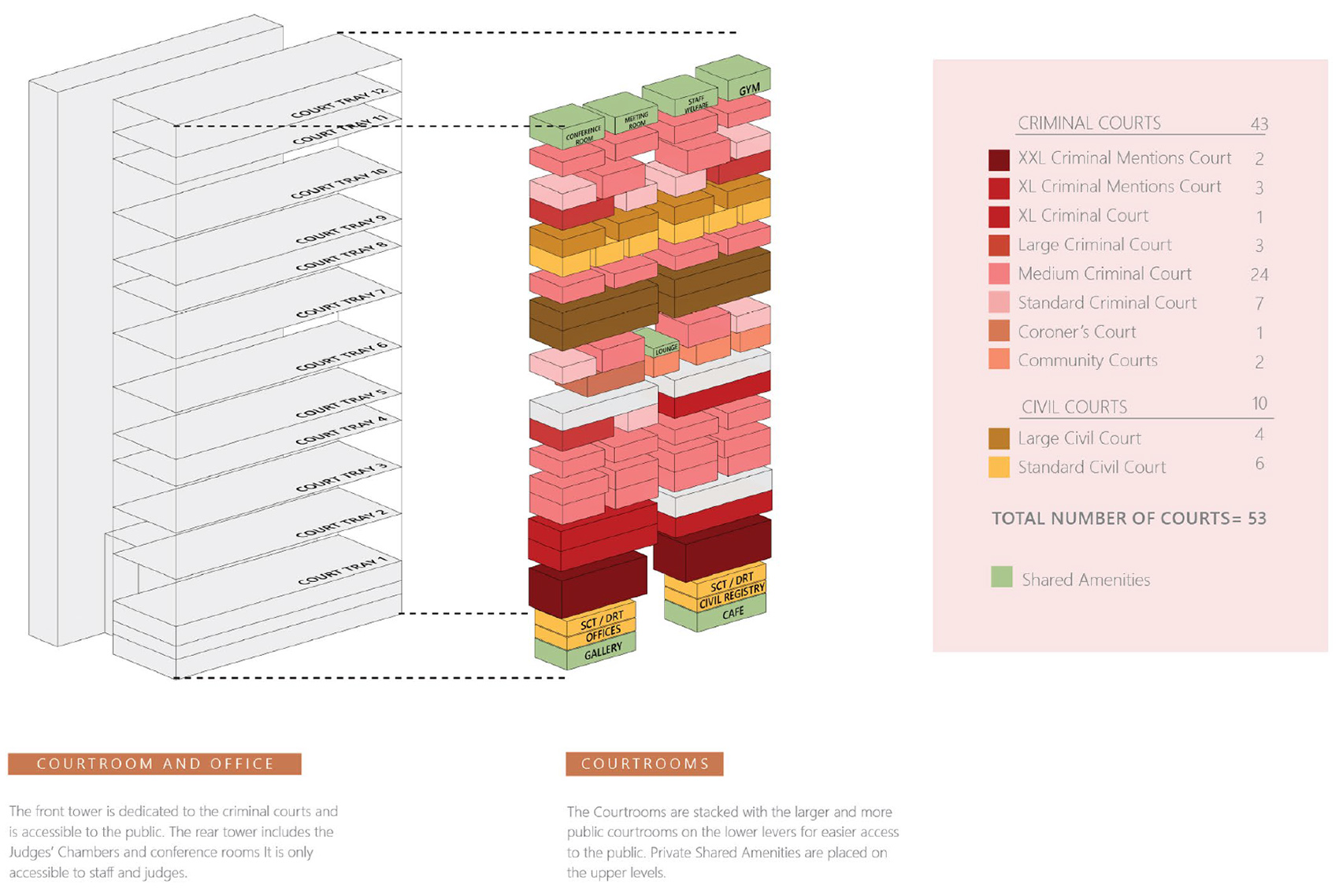
Commenting on the intricacies of court planning, Colin Wu, Lead Architect and Senior Vice President of CPG Consultants said, “CPG has historically designed and constructed many of Singapore’s present court buildings, such as the Supreme Court and Family Justice Courts. Our familiarity in court complex design and planning in Singapore helped us in designing the programmatic spaces, operations, and security requirements for this first, high-rise court complex. Our aim in this project was to ensure there is clear segregation in the programming of the three primary user groups, the judges, persons-in-custody, and the public.”
The site for the new State Courts towers is also smaller, meaning that vertical court towers, as compared to a more common, horizontal layout would have to be planned. This posed a challenge, as careful planning and stacking of the 53 courtrooms and 54 hearing chambers, is necessary to ensure that court operations will be in no way hindered. One of the successful outcomes was the simplicity in the vertical stacking of its programmes and circulation that made wayfinding easy for the public.
▼法庭大楼首层大厅,courtroom lobby © Khoo Guo Jie
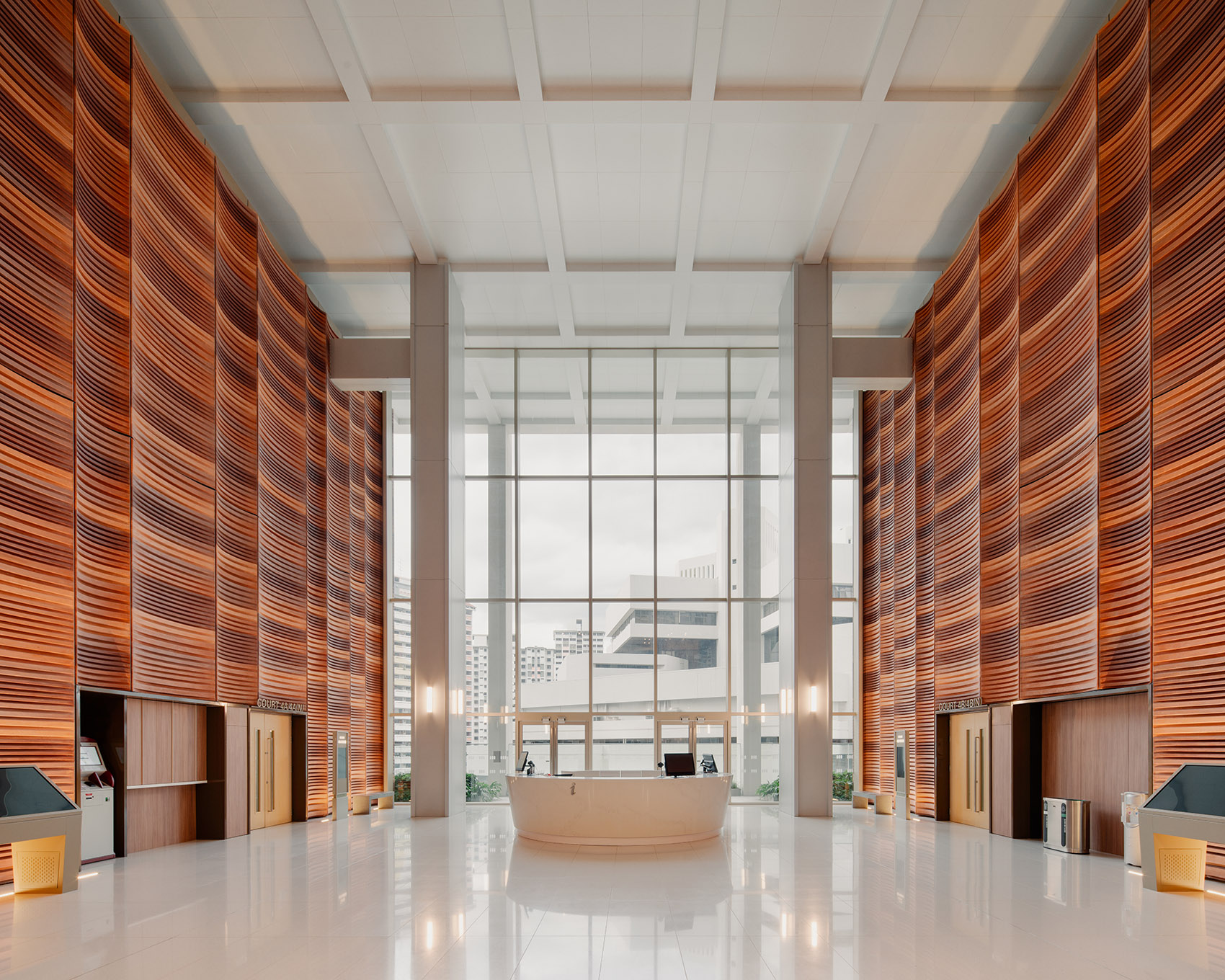
▼法庭所在体量采用预制板饰面,其灵感源于附近店屋的陶瓦屋顶 Courtrooms with pre-cast panels inspired by terracotta roofs © Khoo Guo Jie

▼法庭内部,courtroom interior view © Khoo Guo Jie
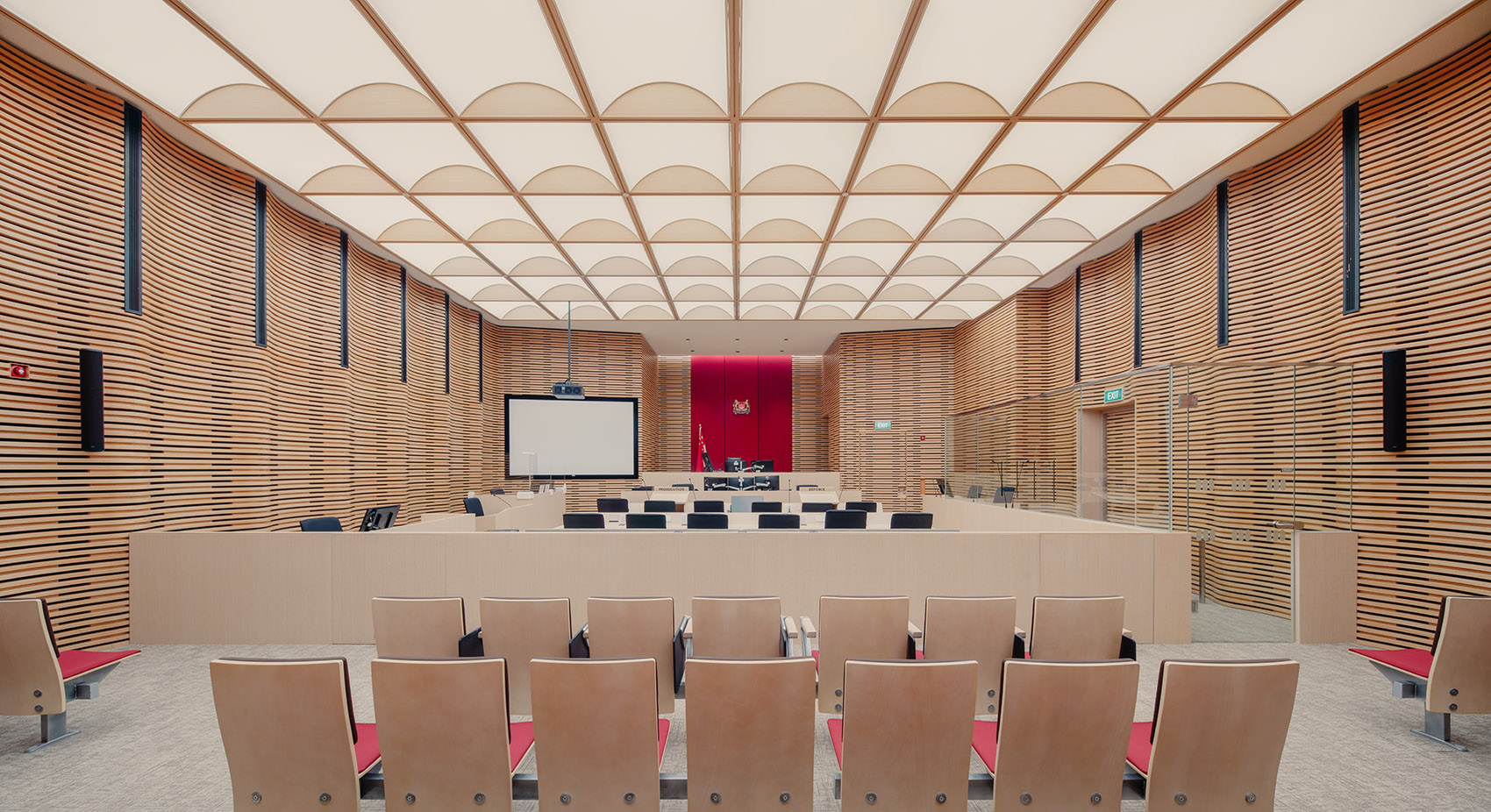
As a modern and IT-enabled courthouse, the complex also took on various smart building features like facial recognition and automation of various building management processes related to security and, mechanical and electrical systems. Other IT or web-enabled services introduced include video-conferencing facilities and interactive self-service kiosks. In addition, as a modern courthouse, a universal design approach was adopted to ensure that it is user-friendly to the judges, persons in custody and the public, for example in providing assistive listening systems for court attendees and in all its courtrooms, digital wayfinding through the use of apps, child- minding facility, etc.
▼法院大楼与周边环境 © Finbarr Fallon The new State Courts towers and its surroundings
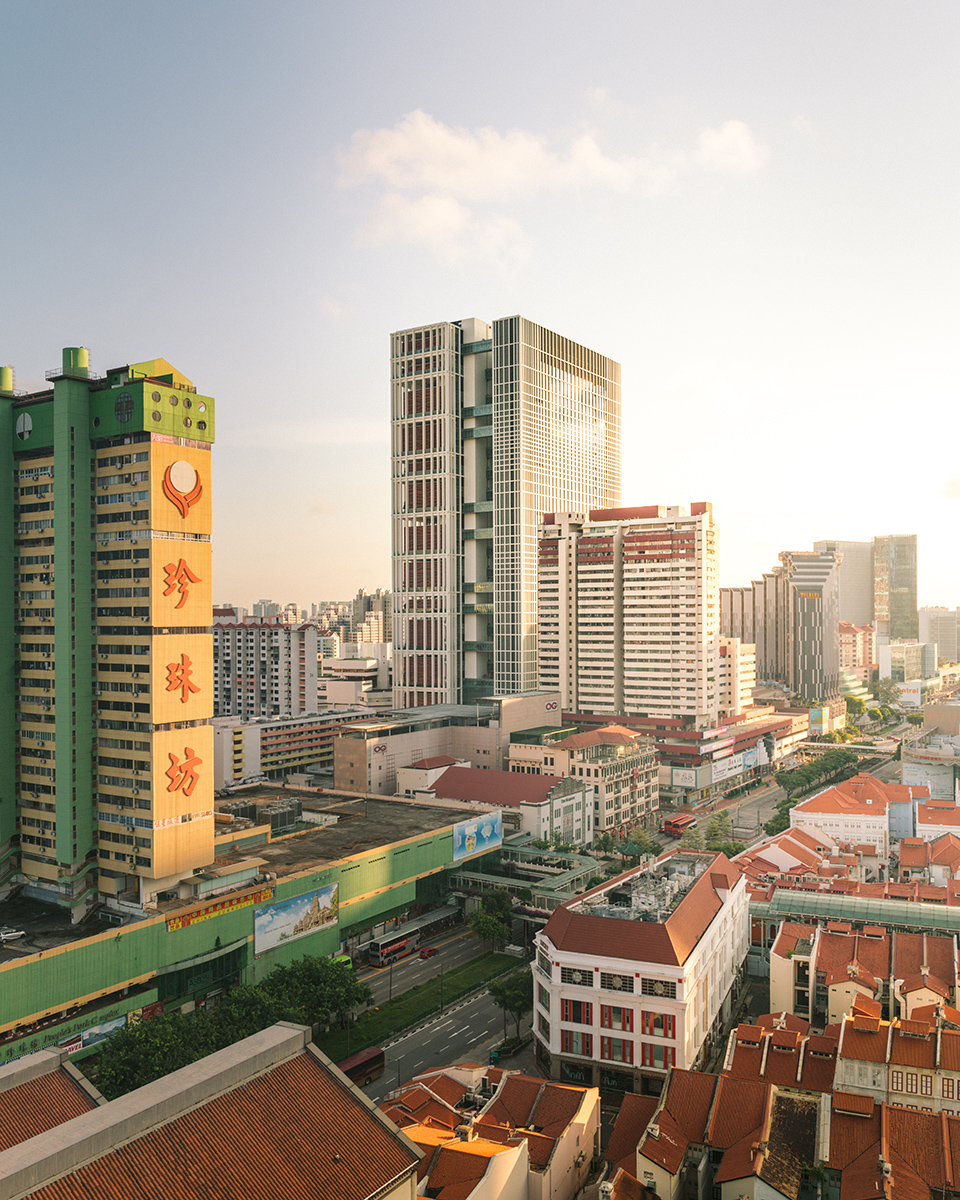
法院大楼还是一座环境可持续的建筑,其设计结合了太阳能电池板和冷凝水回收系统等创新的绿色建筑特征,并于2018年被授予BCA绿色建筑标志白金奖。
The State Courts towers is also an environmentally sustainable building, with innovative green building features incorporated in its design, such as solar panels and condensate water recovery systems. It was awarded the BCA Green Mark Platinum award in 2018.
▼夜景,night view © Finbarr Fallon
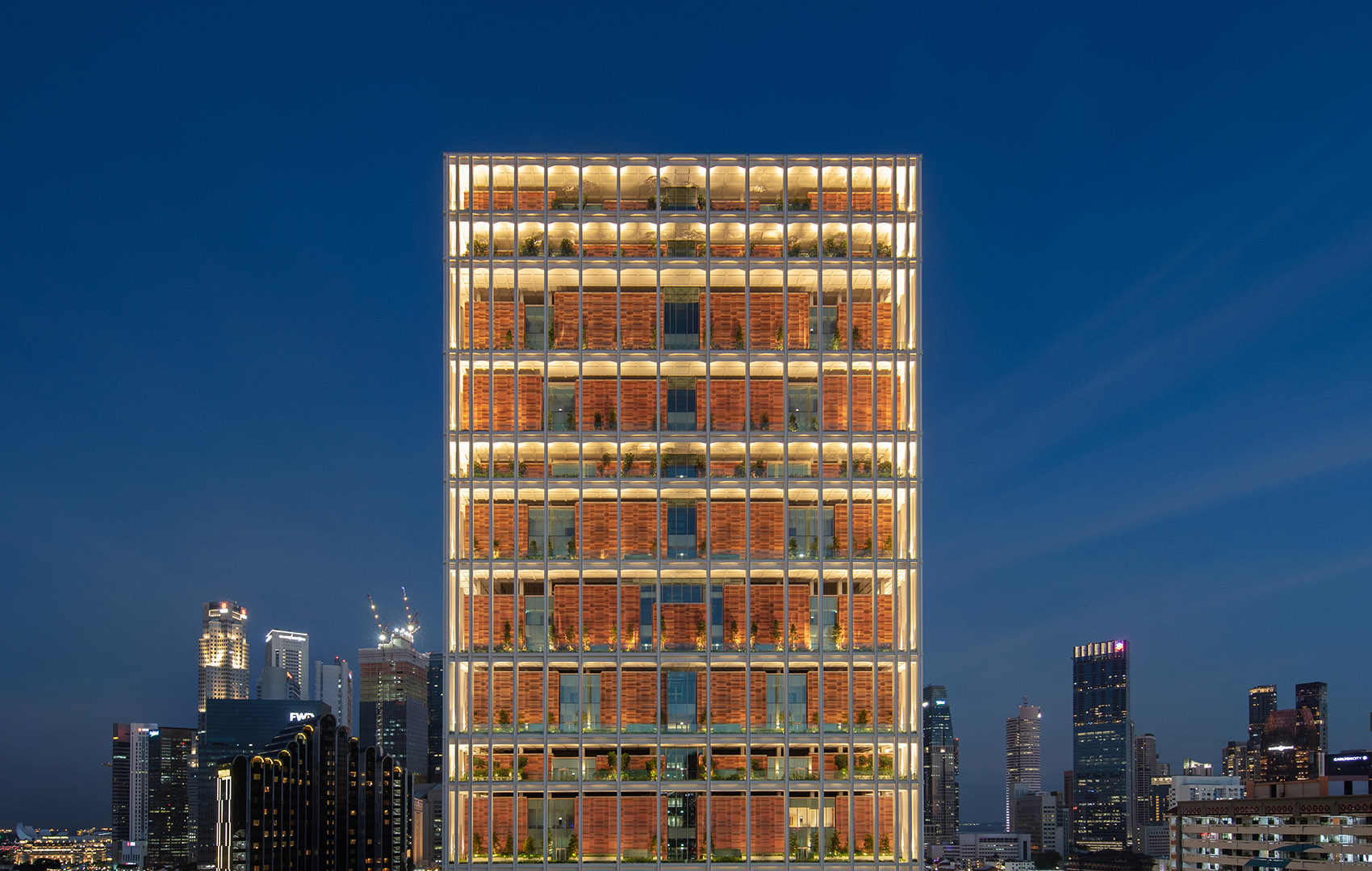
▼场地平面图,site plan © Serie Architects
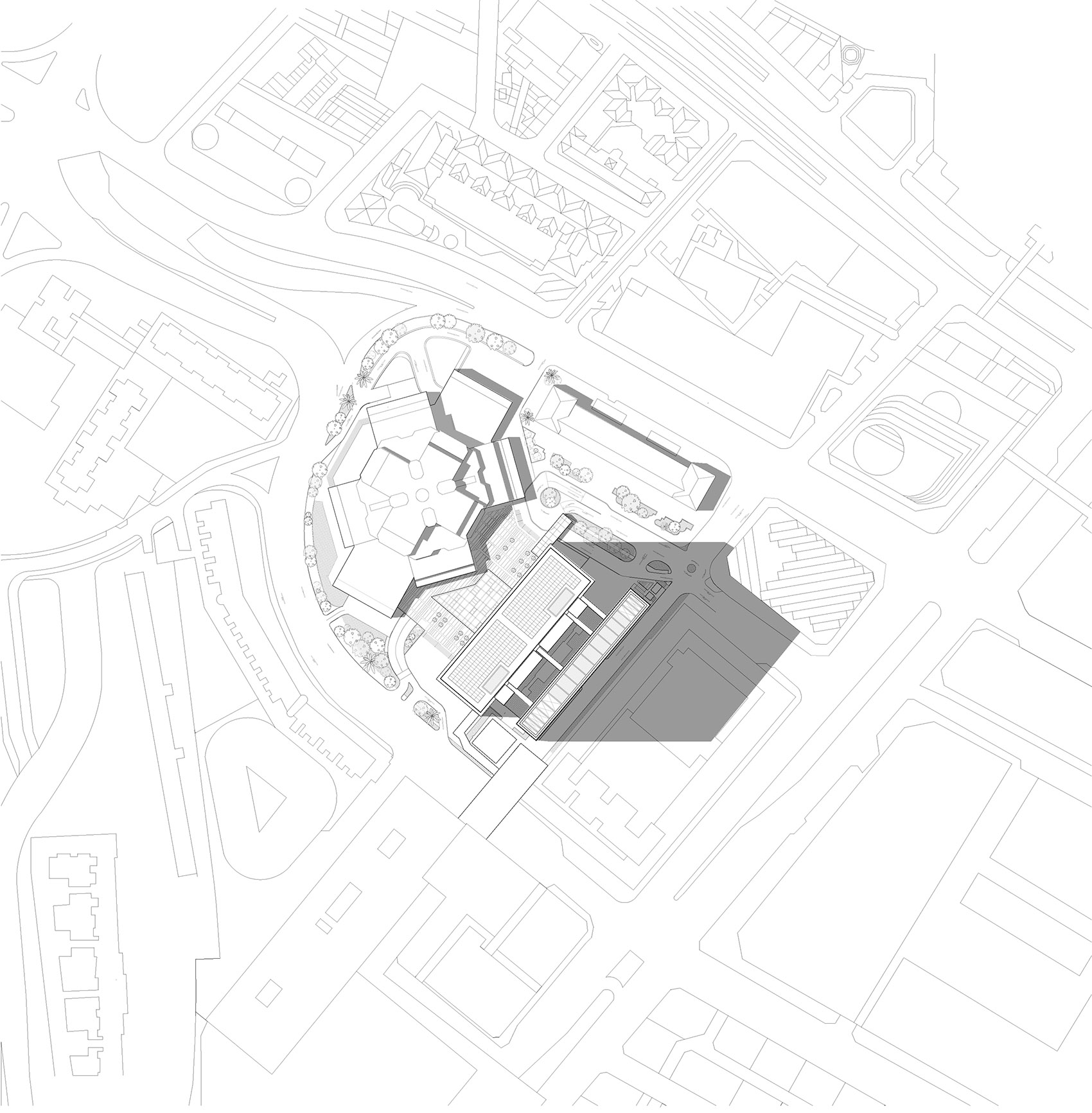
▼主立面,Front elevation © Serie Architects
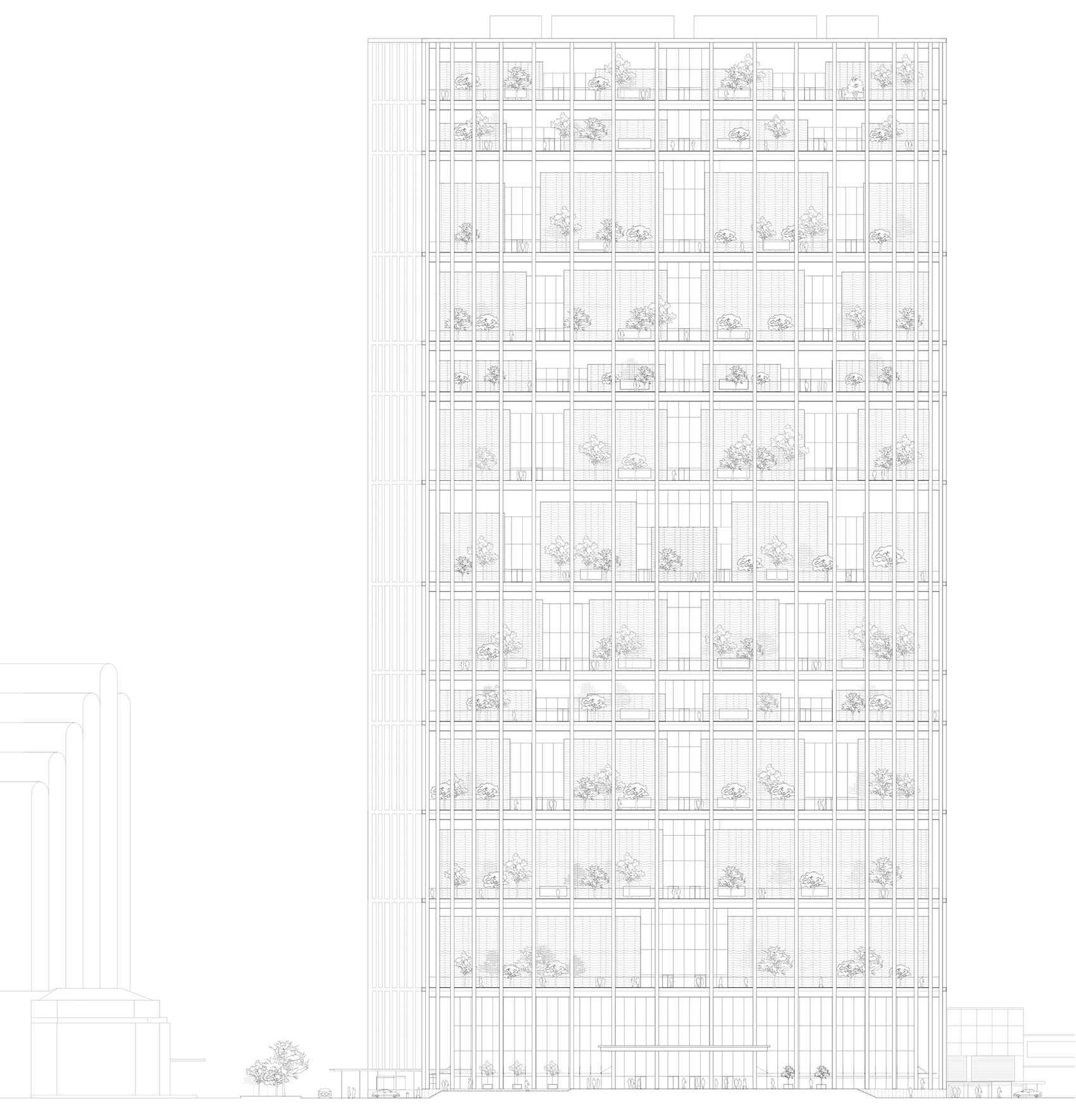
Building Type: Judiciary / Courthouse Name of Client: State Courts Country: Singapore Year of Completion: 2019 Operation Start Date: 2019 Gross Floor Area: 113,000 sqm
Design Consultant: Serie+Multiply Architects Pte. Ltd Principal Consultant and Architect: CPG Consultants Pte. Ltd
Consultants: Civil & Structural Engineering: CPG Consultants Pte. Ltd Mechanical & Electrical Engineering: CPG Consultants Pte. Ltd Quantity Surveyor: CPG Consultants Pte. Ltd Project Management: PM Link Pte. Ltd Facade Consultants: HCCH Consulting Pte. Ltd / Building Facade Grp ID Consultant : SCA Design Pte. Special Lighting: Ong & Ong Pte. Ltd Landscape: Plantwerkz Pte. Ltd Signage & Wayfinding: Square Peg Design Acoustic & AV Systems: Alpha Acoustics Engineering Pte. Ltd Environmental Sustainability Design Consultant: Surbana Int’l Consultants Pte. Ltd Security & Blast: Certis Cisco Consulting Services Pte. Ltd
